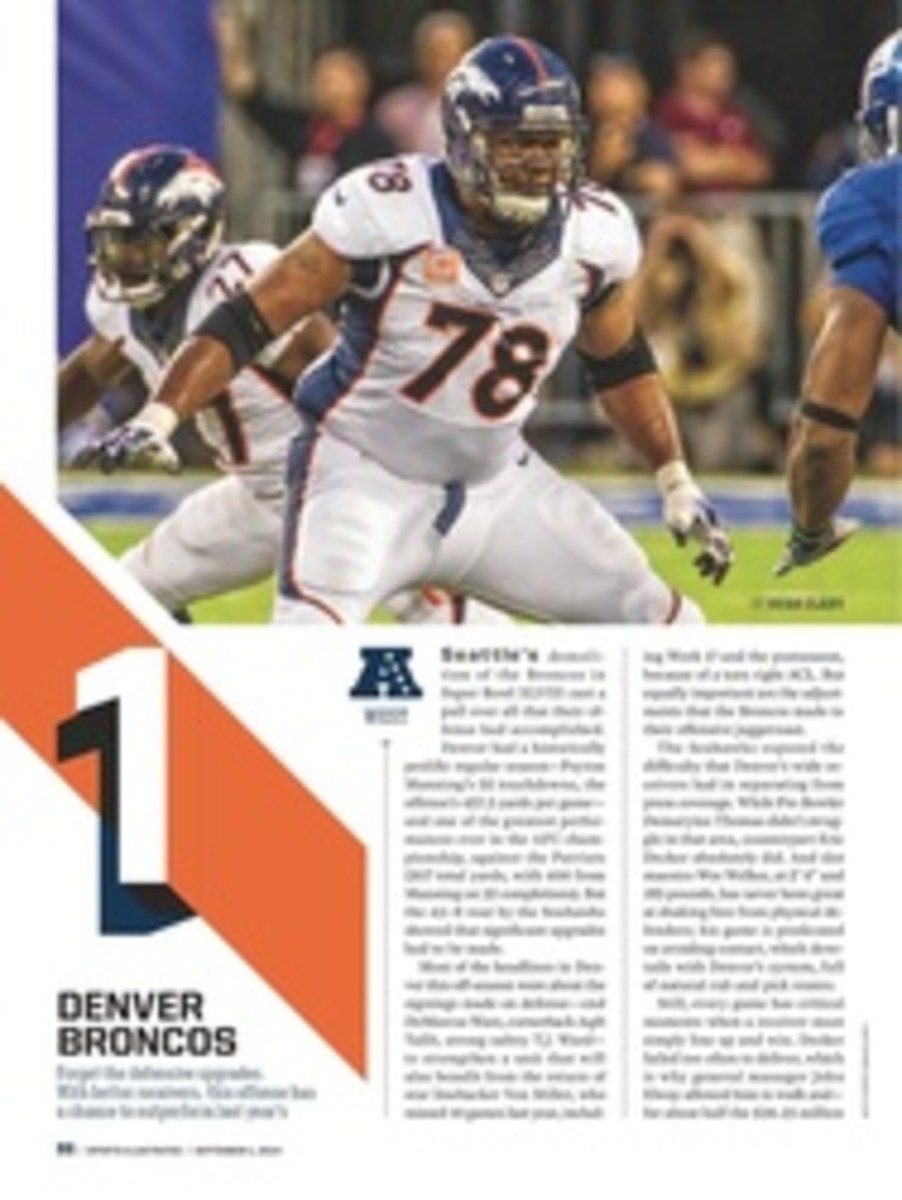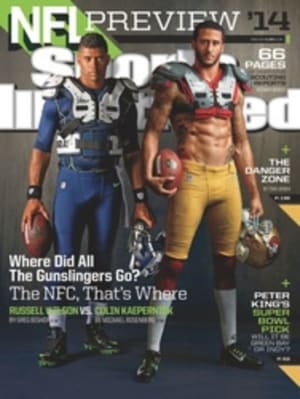
4 MINNESOTA VIKINGS
Adrian Peterson is the best downhill runner in football, by far. The gap between Peterson and the next guy is the biggest chasm between any two players at the top of their category.
But you could argue that Peterson's greatness has been pointless in recent years, since the Vikings have mostly floundered on the other side of the ball. A run-first offense demands superior defense for a couple of reasons: 1) games tend to be closer and lower scoring because rushing eats up more clock, and 2) teams with weak defenses often fall behind, forcing them to abandon the run. This explains why general managers prefer to build around a quarterback instead of a running back: No game situation can effectively remove a great passer from the offensive equation.
Last year Minnesota's defense seemed to specialize in surrendering big plays. It ranked 30th in opponents' success rate on third down (44.2%) and, despite using a simplistic Cover Two--based scheme designed to force turnovers, was next to last in the NFC in that statistic, with 20.
Enter Mike Zimmer, a 58-year-old first-time head coach and former Bengals defensive coordinator who has made his living forcing opponents into mistakes with confusing presnap looks and aggressive play-calling. One of Zimmer's staples is placing a linebacker on each side of the center before the snap, a tactic known as "sugaring the A gaps." This forces the offensive line to adjust its protections to the inside, leaving one-on-one matchups for pass rushers outside. From there Zimmer loves to drop a lineman into coverage, creating a zone blitz or zone exchange in which an unconventional pass rusher replaces a conventional one after the snap. He'll also blitz a safety off the edge and disguise his coverages.
The nice thing about Zimmer's defense is its only severe need is for defensive linemen who can drop into shallow coverage or consistently win one-on-one pass-rushing battles—and the Vikings have them. Despite having only 17½ sacks in four seasons, end Everson Griffen received a five-year, $42.5 million contract with $19.8 million guaranteed because of his versatility and the explosiveness he has flashed. In Zimmer's scheme he will thrive.
Rookie linebacker Anthony Barr, the No. 9 pick out of UCLA, will have a chance to shine as well. A 6'5", 255-pound outstanding athlete who is still developing, Barr could earn a role in the nickel package, and he'll get serious consideration as a base 4--3 strongside linebacker, a position at which the Vikings need help.
Leading the 'backers is Chad Greenway, who can blitz or drop into coverage and should excel as an A-gap mugger. One of the men Greenway will be creating single-blocking scenarios for is defensive tackle Sharrif Floyd. The 2013 first-round pick has the short-area movement skills of a player with significant potential, though he also has the subpar ground-holding abilities of a man not guaranteed to fulfill it.
Joining Floyd inside is free-agent pickup Linval Joseph, who, based on his history with the Giants, will make just enough plays to stay in the starting lineup. There's also eight-year veteran Fred Evans, who has the initial burst to be an every-down force but suffers from inconsistency. Former Bears end Corey Wootton, who will push but not beat out eight-year veteran Brian Robison for first-string snaps, also has experience inside. Wootton would only play in pass situations, though, given his susceptibility against the run.
In the secondary third-year safety Harrison Smith offers great awareness. It will be interesting to see whether Zimmer puts the potential Pro Bowler in centerfield or in the box, where he could rush off the edge. There may not be room for Smith up front, however, as Minnesota signed former Panthers cornerback Captain Munnerlyn not just for his coverage acumen but also for his blitzing ability from the slot. Munnerlyn's taking the slot corner role will allow speedy third-year man Josh Robinson to play outside, opposite '13 first-round pick Xavier Rhodes, who can be suffocating with jams off the line of scrimmage, but only if he's near the boundary.
You wouldn't call the Vikings' individual pieces great, but under Zimmer's orchestration, they're good enough to make a superstar running back much more relevant.
2014 SCHEDULE
2013 Record: 5-10-1
WEEK 1
STL [AWAY]
NE [HOME]
NO [AWAY]
ATL [HOME]
GB THUR [AWAY]
DET [HOME]
BUF [AWAY]
TB [AWAY]
WAS [HOME]
BYE
CHI [AWAY]
GB [HOME]
CAR [HOME]
NYJ [HOME]
DET [AWAY]
MIA [AWAY]
CHI [HOME]
WEEK 17
MAJOR CONCERN
The quarterbacks
Let's be honest: The Vikings drafted Teddy Bridgewater out of Louisville with the last pick of the first round because they felt compelled to take a quarterback. And that was only because in 2011 they also felt they had to take a first-round quarterback, and that selection, Christian Ponder, hasn't worked out. If winning right away is important, Bridgewater will spend his rookie season taking notes while watching Matt Cassel lead the offense. Cassel is by no means a star, as demonstrated by his years with the Chiefs, but he has the skill set to execute the system of new coordinator Norv Turner, which is big on throwing passes in the 15-to-20-yard range. The rub: Without a big arm, Cassel needs sound protection so he will have space to step into throws. While Cassel is tough enough to deliver the ball when he's about to get hit, he's not effective when doing so. The Vikings' offensive line—LT Matt Kalil, LG Charlie Johnson, C John Sullivan, RG Brandon Fusco and RT Phil Loadholt—is decent in the run game, but it tends to struggle in pass protection. For Cassel to do well, he needs Kalil, the fourth pick of the '12 draft, to play consistently to his capabilities.
THE CASE FOR
Receiver Cordarrelle Patterson
Last year Patterson looked every bit the unripe rookie who played only one season of major college football, at Tennessee. But the former junior college track star also showed the playmaking talent that inspired GM Rick Spielman to trade back into the first round to get him with what ended up being the third of Minnesota's three first-round picks in 2013. Besides averaging a league-best 32.4 yards on kick returns (and running back two for touchdowns), Patterson late in the season developed into a viable contributor on offense, doing more than just catching the quick screens that then coordinator Bill Musgrave had designed for him. New coordinator Norv Turner's system expands almost all pass patterns by roughly 20% of their standard length. If Patterson can build on his encouraging, though still primitive, route running, he'll be a big-play weapon in Turner's field-stretching scheme.
PHOTO
MATTHEW EMMONS/USA TODAY SPORTS
DE EVERSON GRIFFEN
PHOTO
JONATHAN DANIEL/GETTY IMAGES
NINTEEN PHOTOS

